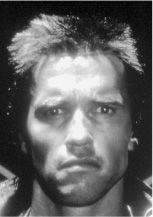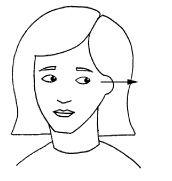The Definitive Book of Body Language (30 page)
Read The Definitive Book of Body Language Online
Authors: Barbara Pease,Allan Pease

Provided your gaze doesn't drop below the level of their eyes, the pressure will stay on them. Never use this in friendly or romantic encounters. But it works a treat on the person who you want to intimidate or on the person who simply won't shut up.

The Power Gaze
If you have soft, weak, or wimpy eyes practice using the Power Stare to give yourself more authority. When you are under attack from someone, try not to blink while maintaining eye contact. When you look at the attacker, narrow your eyelids and focus closely on the person. This is what predatory animals do just before they strike their prey. When you pan your eyes from one person to another without blinking, it has an unnerving effect on anyone who watches you do it.

Don't mess with The Terminator
To do this, move your eyeballs first and then let your head follow, but your shoulders should remain still. The Power Stare was used by Arnold Schwarzenegger as The Terminator and can strike fear into the hearts of would-be intimidators. Better still, have a policy of dealing only with pleasant people so you'll never need to whip out your Power Stare.
When someone looks around from side to side or won't look us in the eye when they talk, our trust in their credibility diminishes dramatically, even though they may be doing it because of shyness. We had a politician client who was a novice at being interviewed on television and he constantly flicked his eyes between the reporters and the cameras when he was being interviewed. This had the effect of making him look shifty-eyed on the screen and each time he appeared on television his popularity decreased. By training him simply to look at only the reporter and ignore the cameras, his credibility increased. We trained another politician to address his answers mainly to the lens of the television camera when he participated in a televised political debate. While this alienated the 150 studio audience guests, it impressed millions of television viewers, who felt as if the politician was talking directly to them.
For a television show, we conducted an experiment using a dating agency. A selected number of men were told that their next date was well matched to them and that they should expect to have a successful, fun time. We explained to each man that his date had suffered an injury to one eye as a child and that she was very sensitive about it because the eye didn't track properly. We said we weren't sure which eye it was, but if he looked closely he'd be able to pick it. Each woman was also told the same story about her date and that if she, too, looked closely she'd be able to spot the slow eye. On their dates, the couples spent the evening gazing into each other's eyes, searching in vain for the “problem eye.” The outcome was that each couple reported high levels of intimacy and romance on their dates and the likelihood of the couple meeting again for a second date was 200 percent higher than the agency average.
Extended gazing can create intimate feelings.
You can also drive couples apart by telling them that their date has a hearing problem and that they'd need to talk about 10 percent louder than their date to be heard. This results in a couple talking louder and louder as the evening progresses, to the point where they are yelling at each other.
Many people are taught that, in a sales or job interview, you should maintain strong eye contact with the other person and keep it up until you are seated. This creates problems for both the interviewer and interviewee because it's contrary to the process we like to go through when we meet someone new. A man wants to check out a woman's hair, legs, body shape, and overall presentation. If she maintains eye contact, it restricts
this process so he's left trying to steal glances at her during the interview without getting caught and so he becomes distracted from the actual job of interviewing. Some women are disappointed that, in a supposedly equal business world, men still do this, but hidden cameras show this to be a fact of business life whether we like it or not.
Like it or not, everyone steals a look at a woman's rear when
she leaves a room, even if they don't like her front view.
Video cameras also reveal that women interviewers go through the same evaluation process with both male and female interviewees, but women's wider peripheral vision means they rarely get caught. Women are also more critical than men of female interviewees whose appearance doesn't stack up. Women look at a male candidate's hair length, clothes design, and coordination, the creases in his trousers, and shine on his shoes. Most men are completely unaware that women look at the condition of the
back
of his shoes as he walks out.
When you go for an interview, shake hands and then give the interviewer a two- to three-second frame of uninterrupted time for them to complete the process of looking you over. Look down to open your briefcase or folder, or to arrange any papers you might need, turn to hang up your coat, or move your chair in closer, and then look up. In filming sales interviews, we found that not only did the interviews feel better for the salespeople who used this strategy, it added up to a better outcome in sales results.
A person's eye movements can reveal what their mind is focusing on by telling you whether they are remembering something
they have seen, heard, smelled, tasted, or touched. This technique is a development of American psychologists Grinder and Bandler and is known as Neurolinguistic Programming, or NLP.
In simple terms, if a person is remembering something that they saw, their eyes will move upward. If they are recalling something they heard, they look to the side and tilt their head as if listening. If they are recalling a feeling or emotion, they'll look down and to the right. When a person is mentally talking to themselves, they look down and to the left.

A. Recalling a picture

B. Recalling a sound

C. Recalling a feeling

D. Talking to oneself
The difficulty is that these eye movements can occur in a fraction of a second and come in clusters, making it harder to read
“live.” A videotape replay, however, can let you see discrepancies between what a person says and what they really think.
Thirty-five percent of people prefer the visual information channel and will use phrases such as “I see what you mean,” “Can you look into that?” “That's perfectly clear,” or “Can you show me that?” and you will get their attention by showing them photos, charts, and graphs and asking if they “Get the picture.”
Twenty-five percent prefer the auditory channel and use words such as “That rings a bell,” “I hear you,” “That doesn't sound right,” and that they want to be “in tune” with you. The other 40 percent prefer the feelings channel and will say “Let's kick that idea around,” “Our department needs a shot in the arm,” “I can't quite grasp what you're saying.” They love to test drive things and be involved in a demonstration so that they can “grasp the idea.”
NLP is a remarkable discovery and a powerful communications tool that should be addressed as a separate subject. We suggest you follow up by reading the work by Grinder and Bandler mentioned in the reference section at the back of this book.
As professional conference speakers, we developed a technique for keeping an audience's attention and letting them feel involved. In groups of up to fifty people it's possible to meet the gaze of each individual. In larger groups you usually stand farther back, so a different approach is needed. By pegging a real or imaginary point or person at each corner of the group and one in the center, when you stand at a distance of ten yards from the front row, approximately twenty people in a group of up to fifty will feel you are looking at them individually as you speak and so you can create an intimate bond with most of your audience.